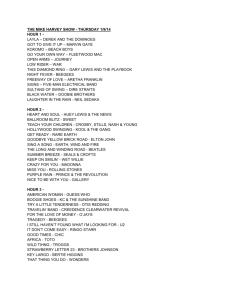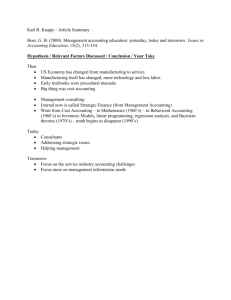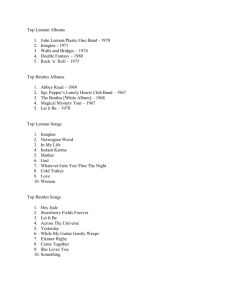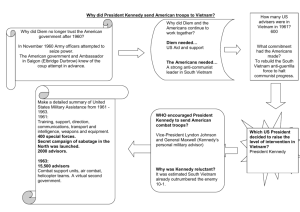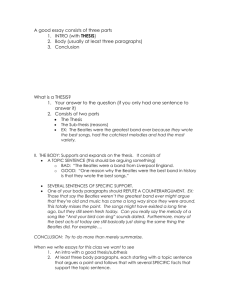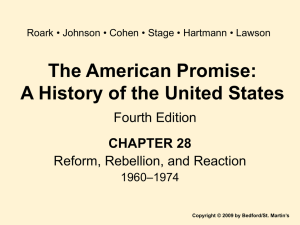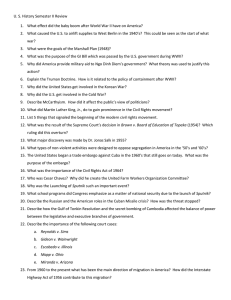The 1960s - 5
advertisement
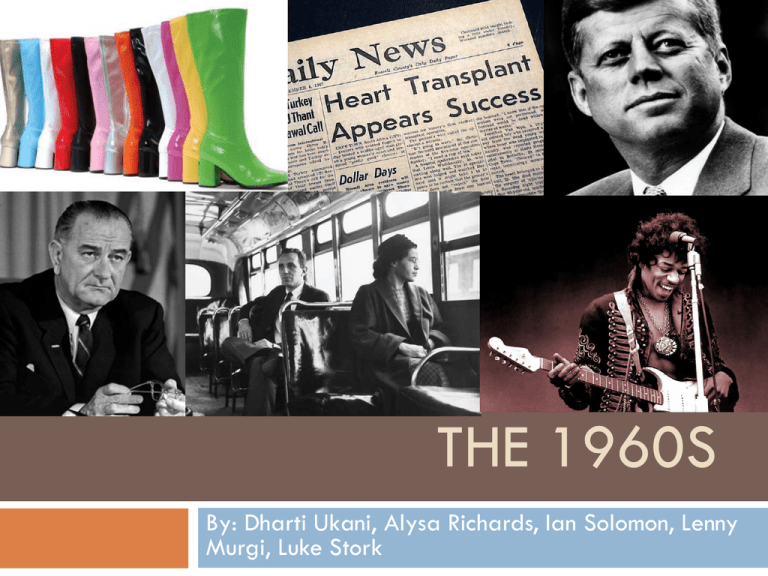
THE 1960S By: Dharti Ukani, Alysa Richards, Ian Solomon, Lenny Murgi, Luke Stork TARGET: Explain the roots of the civil rights movement: Brown vs. Board of Education, Little Rock Nine, Montgomery Bus Boycott (Question 1) Plessy vs. Ferguson: a lawsuit brought in 1896 after African American Homer Plessy was denied a seat in a first-class railway Plessy vs. Ferguson relates directly to Brown vs. Board of Education because Plessy vs. Ferguson was overturned by Brown vs. Board of Education (Question 3) NAACP had long waged a campaign against segregation in educational facilities Plessy vs. Ferguson had established the legality of separate but equal schools NAACP had succeeded in opening some all-white schools, however, the Court continued to maintain that segregation in and of itself was legal TARGET: Explain the roots of the civil rights movement: Brown vs. Board of Education, Little Rock Nine, Montgomery Bus Boycott In 1952, a group of legal challenges to segregation in public schools came before the supreme court in the form of Brown vs. Board of Education Main case involved Linda Brown, an African American from Topeka, Kansas Segregation in Topeka’s schools prevented her from attending on all-white elementary schools close to home Had to travel a long dangerous route to school NAACP lawyer, Thurgood Marshall argued on Brown’s behalf Unanimous vote declared racial segregation illegal in public schools (Question 2) TARGET: Explain the roots of the civil rights movement: Brown vs. Board of Education, Little Rock Nine, Montgomery Bus Boycott School desegregation in Arkansas was progressing with relatively little opposition. 2/3 of the southern school districts that began desegregating were in Arkansas. Little Rock school board was the first in the south to announce that it would comply with the Brown Decision Desegregation plan was set to being in September 1957 with the admission of 9 black students to an all white Central High School Governor Orval Faubus spoke out against the desegregation plan and ordered the Arkansas National Guard to surround the school the night before Members of the Arkansas Nation Guard prevented the Little Rock Nine from entering the school for 3 weeks Eventually, the Court ordered Faubus to remove guards, and when the nine finally entered, white mobs rioted Eisenhower ordered some 1,000 troops to Little Rock, and they finally entered after TARGET: Explain the roots of the civil rights movement: Brown vs. Board of Education, Little Rock Nine, Montgomery Bus Boycott December 1, 1955, Rosa Parks, an African American, provided the NAACP with an opportunity to challenge the practice of forcing African American citizens to ride in the back of city buses Parks refused to give up her bus seat to a white passenger and was arrested Park’s arrest for refusing to give up her seat led to her conviction for violating the city’s segregation laws In protest, many of Montgomery’s African Americans organized a boycott against the bus system TARGET: Explain the roots of the civil rights movement: Brown vs. Board of Education, Little Rock Nine, Montgomery Bus Boycott The Montgomery Improvement Association, a group of local civil rights leaders, persuaded the community to continue to continue the boycott while the NAACP and Parks appealed her conviction The MIA chose Martin Luther King, Jr. as its spokesperson, and he inspired large audiences as the boycott dragged on for months Angry white mobs attacked and beat boycotters King studied the nonviolent tactics of Gandhi and urged the African Americans to not respond with violence TARGET: Explain the roots of the civil rights movement: Brown vs. Board of Education, Little Rock Nine, Montgomery Bus Boycott The nonviolent protest finally worked November 1956, the Supreme Court declared the Montgomery and Alabama segregation laws unconstitutional By the end of the year, Montgomery has a integrated bus system, and the civil rights movement had a new leader—MLK Victory marked a blow to racial discrimination http://www.neok12.com/quiz/CIVRIG02 TARGET: Explain the difficulties JFK faced in getting civil rights legislation passed Kennedy faced a great amount of trouble in getting the civil rights legislation passed Many events in Birmingham, such as protests forced President Kennedy to take a stand on civil rights Most of his aides feared that taking a stand would split the Democratic Party and ruin his chances for re-election in 1964 1963—Kennedy asked Congress “to enact legislation giving all Americans the right to be served in facilities which are open to the public.” The Southern Democrats and Conservative Republicans of came together and opposed Kennedy’s agenda They were successful in preventing the legislation from being passed In addition, much of the country was divided in their support of the legislation TARGET: Summarize the major accomplishments of LBJ’s Great Society LBJ is President Lyndon B. Johnson and he had domestic policies that became known as his “Great Society” plan. This plan consisted of making America into a better society. TARGET: Summarize the major accomplishments of LBJ’s Great Society In his first State of the Union message he: Called for a war on poverty in the country, wanted to have a nation that had overcome racial divisions, and called for the creation of a Great Society. Long lasting accomplishments were major contributions that were significant to the protection of civil rights and the expansion of social programs to help the country (like the Jobs Corporation, Medicare, and Medicaid.) Target: Explain both the positive and negative social and cultural changes of the 1960’s. Positive: Culture began to diversify Minorities such as African Americans, women, and gays fought for equality Dr. Martin gave his “I Have a Dream” speech This brought the publics attention to the civil rights movement Target: Explain both the positive and negative social and cultural changes of the 1960’s. Negative: Urban violence due to racism increased During African American rights protests blacks were assaulted and riots broke out This turned the protests violent Womens’ rights timeline 1960 The Food and Drug Administration approves birth control pills. 1960 Women now earn only 60 cents for every dollar earned by men, a decline since 1955. Women of color earn only 42 cents. 1963 The Equal Pay Act, proposed twenty years earlier, establishes equal pay for men and women performing the same job duties. It does not cover domestics, agricultural workers, executives, administrators or professionals. 1964 Title VII of the Civil Rights Act bars employment discrimination by private employers, employment agencies, and unions based on race, sex, and other grounds. To investigate complaints and enforce penalties, it establishes the Equal Employment Opportunity Commission (EEOC), which receives 50,000 complaints of gender discrimination in its first five years. 1966 In response to EEOC inaction on employment discrimination complaints, twenty-eight women found the National Organization for Women to function as a civil rights organization for women. 1968 New York Radical Women garner media attention to the women's movement when they protest the Miss America Pageant in Atlantic City. 1968 The first national women's liberation conference is held in Chicago. 1968 The National Abortion Rights Action League (NARAL) is founded. 1968 Shirley Chisholm (D-NY) is first Black woman elected to the US Congress. Target: Explain the domestic and foreign challenges facing the U.S. at the start of the 1960’s. Starting in the 1960’s the beginning of the womans rights movements resurged forward The last major hurdle that had been overcome was the passage of the 19th amendment Civil Rights protests spurred women of 1960’s to push equal rights for women In 1961 50,000 housewives began to protest Main influential resources was commission on the status of women, founded by Eleanor Roosevelt She had a meeting with pres. JFK Convinced him of the need for equality for women Target: Explain the domestic and foreign challenges facing the U.S. at the start of the 1960’s. Womens’ Liberations group mostly made up of female students Focused on personal experiences in discrimination Their main focus: equality between men and women in employment, education and everything else Civil Rights act of 1964 was signed into law Written to protect the rights of all minorities It protected: freedom of choice to vote, apply for employment, use of hotels, and all public places Vietnam War 1965 – 1975 Target: Evaluate President Kennedy’s motivations for increasing involvement in Vietnam The Vietnam war was a Cold War military conflict in Vietnam. When the North Vietnam invaded the South Vietnam for a communist take over, the U.S. and other nations stepped in and fought against the North and its communist allies. Vietnam War Cont. Target: Evaluate President Kennedy’s motivations for increasing involvement in Vietnam JFK wanted to contain communism from spreading. He felt if Vietnam fell the rest of Asia would fall to. Also a failure in Vietnam would lead to a lost in allies. Later the war, President Lyndon Johnson passed The Gulf of Tonkin Resolution. This bill gave President Lyndon Johnson a the ability to use anything at his power to win the war. America later left the war in 1973 and war itself ended in 1975 TARGET: Explain the Gulf of Tonkin incident and its significance to American foreign policy? How did LBJ respond to the incident? What considerations, domestic and international, contributed to his course of action? In August of 1964, what became know as the Gulf of Tonkin incident occurred It was thought by the public and by Congress that two American ships in water near Vietnam were attacked. In defense to this President Lyndon B. Johnson used the "unprovoked attacks" that weren't really true, to urge America to expand the war efforts. He got whatever means he thought were necessary to win the war after Congress passed the Gulf of Tonkin Resolution LBJ was happy about expanding the war efforts. TARGET: What was LBJ’s strategy for the war in Vietnam? Why wasn’t this strategy successful? President Lyndon B. Johnson's strategy for the war in Vietnam was to overwhelm with lots of air forces and take down quickly. The plan was to take down the transportation passageways that Vietnam was using for war supplies so obviously their forces couldn't be supplied with the things they needed any longer. The fighting that was actually going well for the US but it was the plan of taking down the transportation that didn't go well. Vietnam quickly repaired any damage causing the plan to fail. Historical People of the 1960’s Martin Luther King- led protests and spoke out for Africa American Rights throughout the 1960’s In 1963 Martin Luther King gave his famous “I Have a dream” speech on the steps of the Lincoln memorial It is estimated about 250,000 people were in attendance King was killed on April 7, 1968 Martin Luther King day is celebrated on the third Monday in January each year Historical people of the 1960’s John F. Kennedy- elected president of the United States in 1961 During Kennedy's term he started the trade embargo with Cuba Also the first manned American space flight took place In 1963 President Kennedy was assassinated in Dallas, Texas, by Lee Harvey Oswald Lyndon B. Johnson is sworn in as the thirty-sixth President of the United States Historical Events of the 1960’s Civil Rights Act of 1964guarantees equal voting rights for all citizens regardless of race color religion, or national origin It also prohibited segregation and called for the desegregation of all public schools Bans discrimination, including sex, by employers ad schools Historical Events of the 1960’s Bay of pigs invasion- an unsuccessful attempt by the United States to over throw Fidel Castro as the dictator of Cuba The plan had been created by Eisenhower, then improved and attempted by Kennedy American troops landed in the Bay of Pigs and invaded the southern coast of Cuba After the first hours of fighting the invasion was stopped by Castro's Army Map of Cuba Historic Events and people: space race Oct 1957, Soviet Union launched first Satellite (Sputnik) Russians wanted to make sure people could hear and see it The reaction of the U.S. was astonished and had some fear U.S. first attempts to catch up ended in explosion NASA was created to bring competing military space programs Soon developed rockets, space capsules, satellites, Music The Beatles The Beatles were around in Europe for a few years but not know in America. When they were coming to appear on the Ed Sulivian Show, thousand of posters for the Beatles coming to America were everywhere. When the Beatles stepped of the plane they were greeted with thousands of fans Beatles Cont. The Beatles after coming to America, and being on the Ed Sulivian, The Beatles released the album Rubber Soul and shortly after released the movie Help (which was a comedy staring the band). They toured in 1966 and drew some of the hugest crowds of all time to their show. (The crowds were so huge and loud the band couldn’t even hear themselves on stage.) Beatles Cont. Sick of the life on the road, The Beatles permanently quit touring and worked only on studio albums. Not having to tour the album the band experimented with their music and used new and old tech to farther develop their music. (Sgt. Pepper, Yellow submarine, The White Album) Abbey road was their final album under their producer and it was the album where all of the bands final ideas for the band where released. Beatles Cont. The final album Let it Be was test by the Beatles themselves to see how they developed as band over the year they were a band. The Beatles did their final show on the roof of their studio abbey road and ended with their song “Get Back”. British Invasion The Beatles were the leaders of a movement in American rock world called the “British Invasion” The Rolling Stone If the Beatles were the “good boys” of the British Invasion the Rolling stones were the the bad boys The Rolling Stones hit the American charts with “I Can’t Get No Satisfaction” with other hits of the decade being “Honky Tonk Woman “ “Paint It Black” and “Gimmie Shelter” British Invasion Cont. The Dave Clark Five The second band on Ed sulivian show after Beatles Their # 1 hit in America was “Glad All Over” Animals Their # 1 hit in America was “House of the Rising Sun” After the band broke up the drummer went on to be the drummer for Jimmie Hendrix British Invasion Cont. Kinks They hit the charts with their songs “You Really Got Me” and “Lola” The Who During the British Invasion the Who was already popular in Britain hit the American charts with “I Can’t Explain” then later “I Can See for Miles” At the end of the decade the band release the rock opera which made them world famous “Tommy”. British Invasion Cont. Yard Birds The Yard Birds hit the charts with their song “For your Love” The Yard Birds had many guitarist come through the band including Jimmy Page (Led Zeppelin), Jeff Beck(Solo Work) and Eric Clapton(Cream) After The Yard Birds broke up, Jimmy Page reformed the band and called it The New Yard Birds, in which later the band was called Led Zeppelin Other Music of the Time Eric Clapton After being with the Yard Birds, he created the band Cream and wrote the #1 hits “Sunshine of your Love” and “Crossroads” He later went solo near the end of the 60’s Jimmie Hendrix Jimmie Hendrix He was with the band Isley Brothers and their only hit was “Testify” When he went solo and created “The Jimmie Hendrix Experience” (with the Animals drummer) their first #1 hit was “Hey Joe” with the song that pushed the band into infamy “Purple Haze” at the end of the 60’s. Woodstock Woodstock was a three day concert event that up to .5 million people attended. The Legendary Line Up was The who, Hendrix, Santana, Grateful Dead ,Creedence Clear Water Revival, Janis Joplin and dozens other. TV and Movies Ed Sulivian Show 1949-1971 It was a variety show that exposing the American people to many artist. Some of the guest included Elvis – 60 million views Was shot from the waist up due to Elvis’s suggestive motions Ed Sulivian Show Cont. The The Beatles – 73 million views The Beatles (for bottom dollar pay but top billing and top spot for opening and closing the show Muppets – Reacquiring act Appeared on the show many times First appearance of Kermit TV Cont. The Addams Family 1964 - 1966 Were a satirical version of the ideal American family as they were a wealthy, eccentric family who are unaware that people find them bizarre or freighting Shot in black and white on purpose Flintstones 1960 – 1966 Was a show about a working class Stone Age man’s life with his family The shows popularity rested heavily on its juxtaposition of modern concerns TV Cont. Batman 1966-1968 The show followed the adventures of Batman and his sidekick Robin. The show was noteworthy for its use of onomatopoeia during the climatic fight scenes. The show proved popular turning Batman into a modern pop culture icon. TV Cont. Batman 1966-1968 The show followed the adventures of Batman and his sidekick Robin. The show was noteworthy for its use of onomatopoeia during the climatic fight scenes. The show proved popular turning Batman into a modern pop culture icon. Movies Cont. Star Trek 1966 – 1969 The series was a sci-fi show and series of movies that took place in the future and the show, showed and predicted many technologies. In the show we followed the five year mission of the star ship Enterprise on its mission to explore new worlds and to see out life and new civilizations. The interest of the American people in the show grew due the new advances in technology of the time. INVENTIONS AND DISCOVERIES The 1960s were the beginning of “The Information Age” which means great accomplishments were being made that revolutionized electronics. In the Sixties, people became more comfortable with the idea of automated machines. This era would start the basic inventions for making Americans lives easier. INVENTIONS AND DISCOVERIES: THE HEART TRANSPLANT 1967- Many surgeons in medical centers were on the verge of performing the first ever transplant First heart transplant took place in a hospital in Capetown, South Africa on December 2, 1967 Doctor Christiaan Barnard performed the first ever heart transplant on patient, Louis Washkansky THE IMPACT OF THE FIRST HEART TRANSPLANT Expected that the first transplant would take place in a major American cardiac center where decades of research and preparation had occurred Dr. Barnard used knowledge and skill as most importantly COURAGE to perform the operation The successful transplant raised the the courage of others and freed millions of doctors’ hesitancy As a result, 5 other transplants took place in the next two months, and 170 in the next three years INVENTIONS AND DISCOVERIES: THE FIRST ARTIFICIAL HEART To facilitate the process of heart transplantation, there were many efforts during the 1960s to develop an artificial heart For temporary use in bridging the time gap between a patient's need and the availability of a donor or as an assisting device for people whose hearts are not fully functional INVENTIONS AND DISCOVERIES: THE FIRST ARTIFICIAL HEART The patient: 47-year-old Haskell Karp who was dying of heart failure and awaiting a heart transplant Artificial device was implanted on April 4, 1969, and kept him alive for 3 days until a human heart was available for transplant The artificial heart was about the size of a real heart and made of Silastic, a silicone plastic, had Dacron cuffs to attach to the blood vessels, and an external pump the size of a refrigerator was the power source, attached by hoses through the chest wall Unfortunately, he lived less than two days after the human INVENTIONS AND DISCOVERIES: EARTH SCIENCES During the 1960s, important discoveries in Earth Sciences were made. Americans now had means to tap into the Earth and use it’s heat to produce less expensive electricity. Global Warming (The Greenhouse Effect) was discovered. The earliest known amino acids remains’ were found. Biology Advances Building off of what was discovered in the fifties, scientists did work in Biology labs. The genetic code was cracked, and scientists succeeded in synthesizing active DNA in the lab. INVENTIONS AND DISCOVERIES: DESKTOP COMPUTERS The first desktop computer was invented. Before it, computers took up whole rooms and whole years to learn how to work. Now average Americans could learn to incorporate computers into their everyday lives. More Businesses could start using computers to manage things easier, but it would be a while until the computers became a nationwide thing. INVENTIONS AND DISCOVERIES: DESKTOP COMPUTERS There was almost a new “language” invented for computers in the sixties. This language was far simpler and easier to get fluent in than the one used for computers before. Computers also became a lot less expensive with the newer smaller versions. INVENTIONS AND DISCOVERIES: THE AUTO TELLER MACHINE By the end of the 1960s, however, times were changing A broader segment of the population--more comfortable with the idea of self-service and more willing to trust unfamiliar technologies--was willing to give automated banking a try. 1967--John Shepherd-Barron had the idea of dispensing cash from the machine Barclays, a London bank installed in a branch on Enfield High Street Unlike modern ATMs, Shepherd-Barron’s did not use plastic cards. Used paper vouchers printed with radioactive ink so that the machine could read them. The customer entered an identification code and took the cash By 1970, dozens of U.S. banks had jumped on the ATM bandwagon. THE FASHIONS AND FADS 1960s—decade where it was a great time to be young Youthful culture and fashion had begun to take shape in the 1950s blossomed as never before During the 1960s, the neat and tailored look of the 1950s remained popular Very influential fashion figure: Jacqueline Kennedy The General Fashion Women: generally favored shirtwaist dresses and blouses with coordinated dirndl skirts and older women replaced the skirt with trousers; favorite hairstyles were puffy styles such as the bouffant Men: favored loose fitting trousers and short sleeve, button-front shirts in white or light colors; generally wore their hair in a crew cut called the flattop or short and neatly trimmed with a side part Changing Fashions Fashions of the 1950s played in during the early 1960s. But towards the mid Sixties, fashion took a big turnaround. Some of the biggest changes in Fashion occurred during the 60s. Accessories, materials, and individuality majorly influenced the fashion even into the seventies. The Fashion Takes a Turn Social and political issues began to surface, and found expression in people’s clothing Change came about in the women because of the British-based youth revolution which redefined the idea of feminine beauty emphasizing youth and sex appeal; Example: British fashion model, Twiggy Popularized items were miniskirts, gogo boots, and body stockings The Fashion Takes a Turn: Continued Greatest change in men’s fashion was the adoption of fabrics with bold designs and bright color Became described as the “peacock revolution” because of the bursting forth of colors Chain necklaces also became fashionable Bouffant Hairstyles For a large portion of the 1960’s, big hair was in--it seemed the higher the hair, the happier the woman. The bouffant hairstyle was made popular in large part thanks to Jackie Kennedy. The hairstyle caught on and swept through Hollywood with women all over the world quickly catching on to this hairstyle fad. The bouffant was thought to be ideal because it always looked glamorous and became tantamount with elegant evening and glamorous events. Seemed to be the perfect hairstyle to accompany formal gowns mini dresses and in fact, called attention to a woman no matter what she was wearing. Reached its peak by the mid 1960’s and it seemed a large amount of women were clamoring to sport this style. Nehru Jacket The jacket originated in India in the 1940's, but became popularized in the 1960's when the Beatles wore them for their Shea Stadium concert in 1965. This style was inspired by a jacket traditionally worn by and named after a prime minister of India. Became popular among hippies because of their interest in other cultures and religions and how they influenced types of dress. The jacket itself had a band collar, was singlebreasted and worn in two lengths: either slightly below the knee or several inches below the waist. Skirts and Hemlines Well into the mid sixties, most skirts women wore were long and modest. But in 1965, the invention of the miniskirt came out and skirts got tighter and shorter. Many of these short skirts were worn with leggings or tights, however some weren’t. Blue jeans The “Unisex” look also became popular during the sixties. Blue jeans and a simple T-shirt was in style for both guys and girls. This look definitely carried over into the next century, though in the seventies women made the look more feminine with accessories. Skateboards In the early 1960's companies began to massproduce the first true surfing-inspired skateboards Skateboarding became very popular almost overnight, and companies were fighting to keep up with demand. Was fun and carefree, and a pastime Over fifty million skateboards were sold within a three year period, and the first skateboard contest was held in Hermosa Beach, CA in 1963. Then in 1965 safety experts pronounced skateboarding unsafe - urging stores not to sell them, and parents not to buy them. The skateboarding fad died as quickly as it had started, and the sport entered its first slump. GI Joes G.I. Joe was an attempt by the Hasbro Toy Company to recreate the Barbie phenomenon with boys. Popular belief at the time was that boys didn't play with dolls, so Hasbro coined a new term to describe G.I. Joe as an action figure. 1963--Hasbro began development on a military-themed line of dolls that could be accessorized with different outfits and equipment. 1964--Hasbro released 4 different G.I. Joe models, one for each branch of the US military. The figure was 11 1/2 inches tall. The neck, shoulders, elbows, wrists, waist, hips, knees and ankles all moved, so Joe could assume all kinds of dynamic poses, and the hands were designed so that Joe could actually hold his accessories. G.I. Joe had been an incredible success story for Hasbro, but by 1968 the story seemed to be coming to an end. Americans were war-weary--heightened concern over the effects of violent toys and television programming on children. Sales were declining Sports 1960’s Muhammad Ali: Early Life • Considered a cultural icon • His original name was Cassius Clay • Had bike stolen at young age wanted to beat up thief, trained with Cop • Worked with police officer and soon began his career • In 1956 he won Golden Gloves champ • 3 years later he won Golden Gloves tournament of Champs Sports 1960’s Muhammad Ali: Olympic Gold 1960’s he got a spot on the Olympic Boxing team Known for powerful jab and footwork Won 1st three fights in Olympics In championship he defeated Zbigniew Pietrzkowski from Poland to win Gold After Olympics Ali turned professional Sports 1960’s Muhammad Ali Won most of his bouts, most of them knockouts Knocked out Sonny Litson to become heavyweight champ of world Known for boasting about his skills before a fight Told reporters he could, “float like a butterfly sting like a bee.” Sports 1960’s Muhammad Ali: Conversion to Islam First called himself Cassius X But then chose Muhammad Ali Refused to acknowledge military service Said was practicing Muslim Minister, religious beliefs kept him from fighting U.S department of Justice held case denying his claim for conscience Found guilty of refusing to be inducted into military Boxing assoc. took away title and suspended him from sport for 3 and a half years Sports 1960’s Muhammad Ali: Boxing comeback Returned to ring in 1970 Won first fight Ali took on Joe Frazier called the “Fight of The Century” Went 15 rounds Ali knocked Frazier out the later had a rematch and Ali won again Sports in the 1960’s Joe Namath- New York Jets quarterback from 19651976 Won super bowl III (1969) His number (12) was retired by the Jets Sports in the 1960’s Roberto Clemente- Puerto Rican baseball player who played right field for the Pittsburgh pirates for 18 years Involved in many charity work with Puerto rice and other Latin American countries Won The World Series in 1960 and 1971 1960s Video http://www.history.com/videos/tom-brokawremembers-the-1960s#tom-brokaw-remembersthe-1960s
